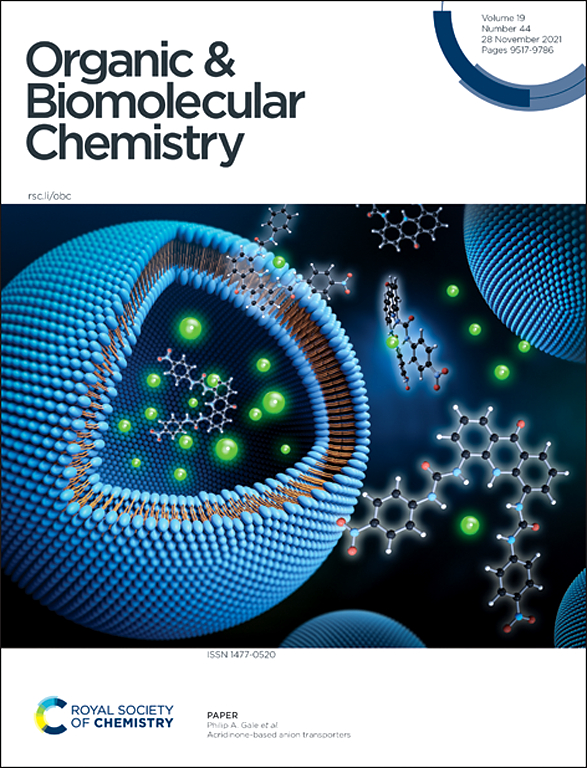烯叠氮化物化学合成1,2,3-三唑啉/三唑及相应的机理方面。
IF 2.7
3区 化学
Q1 CHEMISTRY, ORGANIC
引用次数: 0
摘要
在有机化学中,烯烃和叠氮化合物已被证明是制备各种具有药用价值的含氮杂环化合物的重要合成物。烯-叠氮化物环加成反应可替代叠氮化物-炔环加成反应合成1,2,3-三唑基元。本文综述了1,2,3-三唑啉/三唑啉的合成,重点介绍了非点击技术,并探讨了烯-叠氮化物环加成反应,详细介绍了烯烃结构/电子效应以及与三唑啉不稳定性相关的挑战。研究了活化/应变烯烃合成稳定三唑啉/三唑的策略、反应条件的影响以及分子间/分子内反应。还探索了其他三唑途径。用实例讨论了包括三唑啉转化在内的机理方面。介绍了金属催化/游离方法及其在碳水化合物化学中的应用。本文综述了多种天然产物、具有重要药用价值的支架和其他有机分子的功能化和偶联方法,这些有机分子带有所需支架的烯烃官能团。本文综述可指导合成和药物化学家利用叠氮化物化学设计和开发新型高效的候选药物。本文章由计算机程序翻译,如有差异,请以英文原文为准。
Ene–azide chemistry in the synthesis of 1,2,3-triazoline/triazole and the corresponding mechanistic aspects
Alkenes and azides have been proven to be significant synthons in organic chemistry for the preparation of diverse medicinally valued nitrogen-containing heterocycles. The ene–azide cycloaddition reaction appears as an alternative to azide–alkyne cycloaddition for the synthesis of 1,2,3-triazole building blocks. This review surveys 1,2,3-triazole/triazoline synthesis, focusing on non-click techniques, and explores ene–azide cycloaddition reactions, detailing alkene structure/electronic effects and challenges associated with triazoline instability. Strategies for stable triazoline/triazole synthesis using activated/strained alkenes, effects of reaction conditions, and inter/intramolecular reactions are examined. Alternative triazole routes are also explored. Mechanistic aspects including triazoline transformations are discussed with illustrative examples. Metal-catalyzed/free methods including applications of carbohydrate chemistry are presented. This review discloses various approaches for the functionalization and conjugation of diverse natural products, medicinally significant scaffolds, and other organic molecules, bearing olefinic functional groups with the required scaffolds. This review could guide synthetic and medicinal chemists to design and develop novel and efficient drug candidates using ene–azide chemistry.
求助全文
通过发布文献求助,成功后即可免费获取论文全文。
去求助
来源期刊

Organic & Biomolecular Chemistry
化学-有机化学
CiteScore
5.50
自引率
9.40%
发文量
1056
审稿时长
1.3 months
期刊介绍:
Organic & Biomolecular Chemistry is an international journal using integrated research in chemistry-organic chemistry. Founded in 2003 by the Royal Society of Chemistry, the journal is published in Semimonthly issues and has been indexed by SCIE, a leading international database. The journal focuses on the key research and cutting-edge progress in the field of chemistry-organic chemistry, publishes and reports the research results in this field in a timely manner, and is committed to becoming a window and platform for rapid academic exchanges among peers in this field. The journal's impact factor in 2023 is 2.9, and its CiteScore is 5.5.
 求助内容:
求助内容: 应助结果提醒方式:
应助结果提醒方式:


